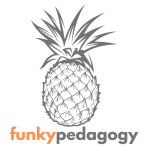If there has been one pattern in my teaching career, it has been the slow realisation that nothing is worth doing unless it can answer ‘yes’ to two questions:
1) Can it be re-used, and/or integrated into a regular part of my practice?
2) Will it make students active, rather than passive participants in their own learning?
1) We spend so much time creating resources and setting up activities that we need to be discerning about the things we spend our precious time on. I never spend time making something unless I am going to laminate or cover it with sticky-back plastic, and bring out again or refer to it on a regular basis.
2) No matter how innovative or beautiful a resource is, if YOU have put more time into it than the students will, then it is not doing the right job! Some resources make students lazy – a beautiful learning mat, revision resource or word wall is a lovely thing to have, but is it asking students questions? Prompting them? Challenging them? OR is it just giving them the answers and allowing them to be passive?
A good display can save you hours of work and help to establish familiar classroom routines. The displays below are all reusable and interactive…
1. Sentence Structures
This display was designed by my very creative colleague, Kat Lang (@Kat_Stubbs), based on the sentence structure work done by Chris Curtis (@Xris32). Peg a range of sentence structures onto a ‘washing line’ so that students can use them for inspiration when doing written work. This can be directed by you, or students can simply opt to use them when they see fit. Laminate the sentences so that they will last all year!
2. DIRT (Directed Improvement and Reflection Time)
Create a selection of reflective tasks based on the skills students need to develop, and attach them to a display so that students can select their own DIRT tasks to improve their work. Tasks could involve instructions such as, “VOCABULARY: Choose three words in your work and use a thesaurus to replace them with three more effective words or phrases,” Or “ANALYSIS: Can you link this text (or the ideas in it) to any books, poems, films, songs you have experienced? Try to explain how, using examples.,” Or “FORMALITY/TONE: Why is it important to get the level of formality in a piece of writing exactly right? Can you think of a time you have NOT got the formality right?”
This example shows a DIRT wall based on a flower garden. The tasks are separated into the skills areas: vocabulary, analysis, writing for effect, formality/tone, structure and metacognition. Each of these areas has a different flower pot and the tasks are on colour coordinated laminated cards.
3. Cookie Jar
This is a brilliantly creative display from my colleague Lizzie Hutchinson. It uses a cookie jar as an extended metaphor for reading skills. There is a biscuit type for every reading AF, and students write examples of their best work on a cookie template to go ‘into the jar’ (in the middle of the display)
Rich Tea biscuit in a jar – information retrieval (because it is a simple biscuit that you have to go in and retrieve)
Jammy Dodger – inference and reading for meaning (because of the good stuff in the middle!)
Pink Wafer – structure and layout (because you can see all the layers)
Millie’s Cookie saying, ‘without you I’d crumble’ – language
Fortune Cookie – culture
Cookie Monster – author’s perspective
4. Formality Scale
This is the brain child of an incredibly talented AST I worked with in a previous school. Students measure their own language and that of their peers (and teacher!) using the formality scale, for example:
Teacher: thanks, a brilliant answer, but where would you rate your language on the formality scale?
Student: about 30%
Teacher: so how could you re-phrase your answer so that it is at 75%?
I tend to add words and phrases which students say a lot around the outside throughout the year, so that they can see where and when that language is acceptable. The scale can also be referred to when setting written work and discussing formality and tone for audience and purpose.
5. Black sugar paper and chalk
VERY simple! Back a display board with black sugar paper and get yourself some chalks in a range of colours. Over the course of a scheme of work, students can write key concepts, quotations, questions and key vocabulary onto the board in chalk. This gives them ownership of the display, and allows them to prioritise the things which really matter to them during the topic.
You can also stick examples of good work, or extracts from texts onto the board and have students annotate them in chalk.
I would love to hear about brilliant long term displays you have used which work! Please get in touch with me: @funkypedagogy and I’ll try to update this blog with the best stuff!








